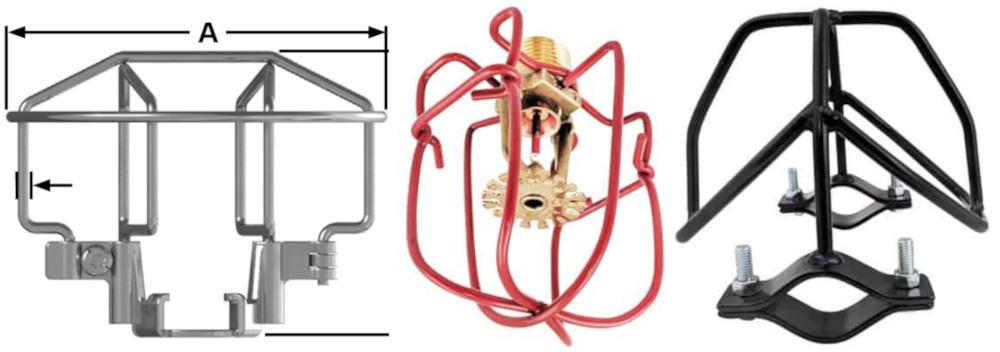Sprinkler guards defend heads from “mechanical damage” and accidental activations
You just knew that letting that guy use the pallet jack was a bad idea. Or maybe you’ve been eyeing that sprinkler under a stairwell and have a bad feeling about someone bumping it. Perhaps the fire inspector has that feeling, too—and says some heads need fire sprinkler head guards, aka “sprinkler cages.”
It’s time to choose a guard and replace or install one. This guide reviews the rules, sizing, and how some different types remove and attach:
- Why and when you need fire sprinkler head guards
- When to replace fire sprinkler guards
- NFPA’s listed requirement
- Sizing head guards
- How to install and replace different types:
Keep your fire sprinklers safe! QRFS has you covered with standard head guards, heavy-duty sprinkler cages, and water shields for in-rack sprinklers. Our inventory of listed models is expanding; for guards not currently in our online inventory, contact us!
Why and when you need to install fire sprinkler head guards
Sprinkler head guards, aka “cages” or just “guards,” protect fire sprinklers from impacts that could damage their delicate parts, especially the fragile heat-sensitive element holding the water back.
NFPA 13: Standard for the Installation of Sprinkler Systems requires them in specific cases:
From the 2022 edition of NFPA 13
16.2.6 Sprinklers subject to mechanical injury shall be protected with listed guards.
What situations constitute “subject to mechanical injury” is a judgment call, but NFPA 13 provides two examples:
- Protecting sprinklers from hits by “pallet loads used in rack storage facilities,” a particular threat to storage sprinklers, including in-rack models.
- Protecting “people [and sprinklers] from injury by sprinklers in areas where clearance is low, such as under a stairwell.”
Other uses for sprinkler guards include gymnasiums, where balls tend to fly. Some people recommend them for sprinklers installed in any highly trafficked occupancy, which have many opportunities for impacts or vandalism.
Again, “subject to mechanical injury” is a judgment call, both by the property owner or designated representative and their authority having jurisdiction who enforces NFPA 13.

When to replace fire sprinkler head guards
Until recently, NFPA 25: Standard for the Inspection, Testing, and Maintenance of Water-Based Fire Protection Systems never discussed head guards. However, the 2023 edition now mandates a yearly inspection of them that syncs up with the annual visual inspection of fire sprinklers:
From the 2023 edition of NFPA 25
5.2.1.1.7.1 Where installed, a sprinkler guard shall be inspected from the floor level annually.
5.2.1.1.7.2 A damaged sprinkler guard shall be replaced with a guard listed for the sprinkler.
NFPA 25 doesn’t detail what constitutes damage, but common sense does. For example, bent, corroded, loose, or broken cages fit the bill.
NFPA’s listed requirement
Both NFPA 13 and NFPA 25 mandate guards that are “listed” for use with a specific sprinkler. It means the entire “sprinkler assembly” has been tested to ensure the cage doesn’t block the head’s spray pattern. However, many non-listed guards exist, and many people use them. What gives?
First, generic guards are designed with specs similar to or identical to certain listed sprinkler cages to avoid spray-blockage issues while selling at lower prices. So, some buyers want the discount, though listed head guards are not particularly expensive. Second, some unlisted “heavy-duty” guards (which we’ll cover shortly) provide more protection against harder hits than listed standard guards, and the major sprinkler manufacturers simply don’t offer this option.
However, users should prioritize listed guards where possible. Otherwise, anyone wishing to employ unlisted cages should check with their authority having jurisdiction (AHJ) first. NFPA standards give AHJs some discretion to interpret whether specific equipment and conditions meet fire protection objectives without compromising safety.
So, for example, a warehouse manager who needs to ward off heavier pallet impacts may want heavy-duty head guards—and they should check with their AHJ!
Sizing head guards
Another benefit of going with a listed guard is that you always know it will fit a compatible sprinkler. Many head guards fit the two most common sprinkler sizes—those with 1/2″ and 3/4″ threads—but not always.
For example, the Victaulic and Viking sprinklers shown below are both uprights with 3/4″ threads. However, compare the width/diameter of the base just above the threads; it’s where the base of a standard head guard attaches:
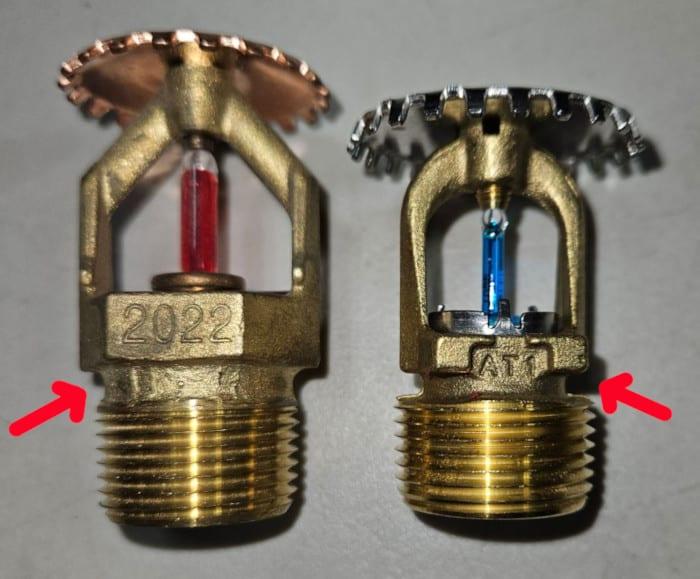
The Victaulic is significantly wider right above the threads. So, if you try to attach a clip-on style head guard that claims it works for both 1/2″ and 3/4″, for example, it’s a tougher fit. These head guards have a two-piece split cage that attaches with clips that stay in place due to tension. Getting a clip on one side in place may be difficult with some larger 3/4″ sprinklers, as shown below:
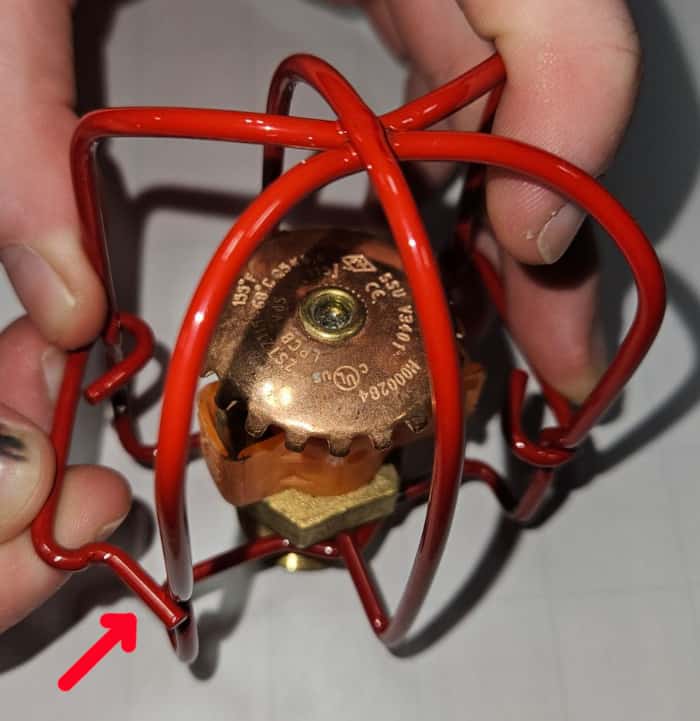
It may be possible to get this guard in place, but fiddling around with clips under tension around a charged sprinkler’s delicate parts is not a fun proposition.
Again, most guards fit 1/2″ and 3/4″ heads fine, but there are exceptions. And listed guards will always fit their compatible sprinklers.
How to install and replace different types of sprinkler head guards
Replacing a sprinkler cage is straightforward, following three general steps—plus a fourth rule:
- Detach the old sprinkler cage from the sprinkler.
- Check the fire sprinkler for any damage. If the sprinkler is damaged or deformed, it also must be replaced.
- Attach the new sprinkler guard, following the manufacturer’s instructions typically found on a data sheet.
- Unless you are “qualified” to do it according to NFPA 25’s definition, default to having a fire protection professional replace head guards.
You can read more about when and how to replace a fire sprinkler in our previous blog entries: Fire Sprinkler Head Replacement: Changes to NFPA 25 Rules and Fire Sprinkler Head Replacement: Who is Authorized to Do It and How?
Fortunately, a professional shouldn’t have to shut off and drain your fire sprinkler system to install a new head guard or replace an old one (unless the sprinkler also needs to be replaced). Most sprinkler cages can be installed and removed from an intact, charged sprinkler.
For installation, there are four main styles of sprinkler guard attachment:
- Standard-duty split cages with halves that interlock into place with clips
- Standard duty split cages that screw into place at the base
- Standard-duty cages with hinges that shut and snap or screw into place
- Heavy-duty head guards that clamp onto sprinkler pipe
Here’s how each attaches to a sprinkler:
Standard split-cage, clip-on fire sprinkler head guards
Many sprinkler guards use clips that secure the cage to itself and around the sprinkler. These guards flex slightly to open and fit over the sprinkler deflector. Then, simple clips, sometimes with snaps, interlock the whole frame together, holding the cage securely in place.
Tyco makes multiple models of this type that are listed for use with its sprinklers. Special tools are recommended to assist with fastening the clips. Many unlisted guards also have this style.
The diagrams below indicate how some clips hold the cage in its final shape:
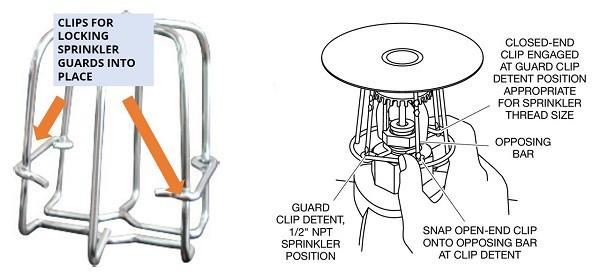
A practical advantage of clip-on cages is that they are usually pretty easy to install. The drawbacks are that they may not stay in place quite as firmly as models that tighten with screws, and it might be impossible to install them on a recessed sprinkler if the base of the head guard is too wide to fit the hole.
Standard split cages that screw into place
Screw-fastened head guards attach to sprinklers slightly differently than the interlocking models. While they still split to fit over a sprinkler head, these models don’t rely on wire tension to hold the guard on. Instead, screws or bolts tighten around the base of the head.
Viking’s Model D-1 sprinkler head guard is a great example:
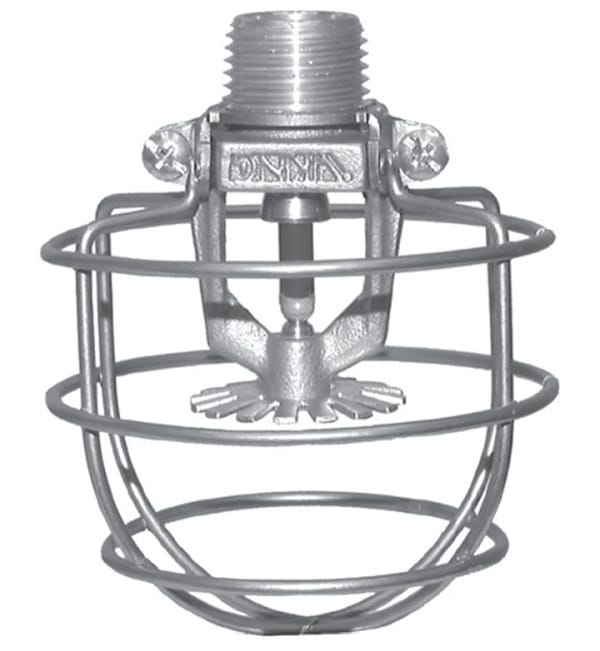
Guards that tighten with screws can be a little tricky to install—sometimes, nerve-racking when putting them on a sprinkler in a system charged with water. Avoiding damage and accidental discharges is one reason a fire protection pro should put them in!
Standard head guards with hinges
These sprinkler guards use a hinge and a latch for easy installation onto sprinklers. The entire cage splits in half like a clamshell. When the hinge is swung closed and latched, it clamps down just below the base of the sprinkler, completing a secure installation.
Viking’s guard for early-suppression fast-response (ESFR) sprinklers uses this design. ESFR sprinklers are powerful choices for protection in storage environments that feature high K-factors and larger, unique deflectors and frames. The hinged installation system of this model helps it fit over these bigger sprinkler heads.
This short video from Viking shows how they attach:
Heavy-duty cages that clamp onto sprinkler pipe
So far, we’ve covered common attachment styles for standard sprinkler cages. However, heavy-duty head guards also exist, and they install much differently. Again, these guards are sometimes used in environments where sprinklers are at risk of harder hits, but they are not listed. Thus, their use is always subject to the approval of the authority having jurisdiction.
Heavy-duty sprinkler cages offer three benefits:
- They’re made of stronger, cold-rolled steel (instead of steel wire, like standard cages)
- They’re bigger, meaning the cage can be crushed more without touching the sprinkler
- They attach to the supply pipe rather than the sprinkler’s base, which may prevent a sprinkler from shearing off completely after a hard impact.
Benefit three makes their installation different from their standard-duty counterparts. Heavy-duty guards are large enough to easily fit over a sprinkler head, and their ends clamp down on the sprinkler branch line, with bolts tightening the clamps.
There are three attachment styles: horizontal mount, side mount, and vertical mount:
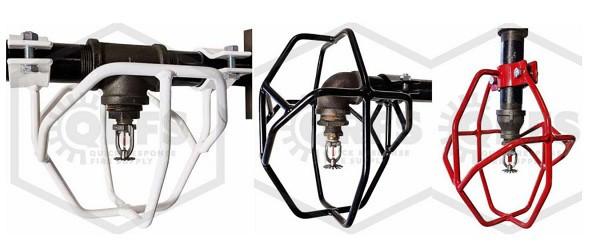
Replacing sprinkler head guards is pretty simple but requires caution
Fire sprinklers protect us, but they also sometimes need a little protection from us. Sprinkler guards can deflect or slow impacts, whether from pallets, broom handles, flying balls, or body parts.
Fortunately, replacing or installing sprinkler cages doesn’t usually require removing the sprinkler. However, working around delicate fire sprinklers in a charged system should always be done with care by qualified individuals.
If you need head guards, QRFS has standard head guards and heavy-duty sprinkler cages, plus water shields. We are also expanding our inventory to carry cages from all major manufacturers—so, contact us if you need a listed guard that’s not online yet.
You can reach us at 888.361.6662 or support@qrfs.com with any questions or help ordering products.
This blog was originally posted at blog.qrfs.com. If this article helped you, check us out at Facebook.com/QuickResponseFireSupply or on Twitter @QuickResponseFS.


